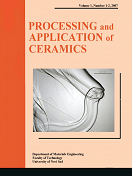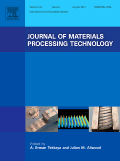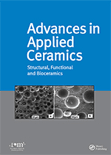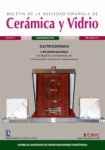
Processing and Application of Ceramics
Scope & Guideline
Pioneering Research in Ceramic Applications
Introduction
Aims and Scopes
- Ceramic Processing Techniques:
Exploration of various methods for the synthesis and processing of ceramics, including sol-gel processing, electrophoretic deposition, and spark plasma sintering. - Characterization of Ceramic Materials:
Investigation of the structural, mechanical, electrical, and thermal properties of ceramics, utilizing advanced characterization techniques. - Functional Applications of Ceramics:
Research on the application of ceramics in diverse fields such as electronics, energy storage, catalysis, and biomedical applications. - Doping and Modification of Ceramics:
Studies focusing on the effects of various dopants and modifications on the properties of ceramic materials to enhance performance. - Sustainability and Recycling in Ceramics:
Research addressing sustainable practices in ceramic production, including the use of recycled materials and environmentally friendly processing methods.
Trending and Emerging
- High-Entropy Ceramics:
Recent publications highlight the development and properties of high-entropy ceramics, which promise enhanced mechanical and thermal stability, making them suitable for extreme conditions. - Bioceramics for Medical Applications:
There is a growing trend in the application of bioceramics in medical fields, particularly in bone repair and regeneration, reflecting the increasing demand for biocompatible materials. - Energy Storage and Conversion:
Research on ceramic materials for energy storage and conversion devices, such as solid oxide fuel cells and capacitors, is gaining momentum, driven by the need for sustainable energy solutions. - Additive Manufacturing of Ceramics:
The integration of additive manufacturing techniques in the production of ceramic components is emerging, allowing for complex geometries and customized applications. - Nanostructured Ceramics:
The exploration of nanostructured ceramics is on the rise, focusing on their unique properties and potential applications in electronics, catalysis, and other advanced fields.
Declining or Waning
- Traditional Ceramics:
There has been a decrease in publications focusing solely on traditional ceramic materials, as the field shifts towards advanced ceramics with specialized applications. - Low-Temperature Processing:
Research on low-temperature processing techniques appears to be waning, possibly due to the increasing focus on high-performance ceramics requiring higher processing temperatures. - Basic Dielectric Studies:
Basic studies on dielectric properties of ceramics are less frequent, as more complex and application-oriented dielectric materials are being prioritized. - Natural Ceramics and Composites:
Studies involving natural ceramics and their composites are becoming less common, potentially overshadowed by synthetic and engineered materials with superior properties. - Inorganic Pigments:
The focus on inorganic pigments for ceramic applications seems to be declining, as the industry trends towards more versatile and advanced coloring techniques.
Similar Journals

JOURNAL OF MATERIALS PROCESSING TECHNOLOGY
Unveiling Breakthroughs in Materials ProcessingJOURNAL OF MATERIALS PROCESSING TECHNOLOGY, published by ELSEVIER SCIENCE SA, is a premier international journal dedicated to the dissemination of cutting-edge research in the field of materials processing. With an impact factor indicative of its high academic quality, this journal features a diverse range of topics, including ceramics, composites, metals, and manufacturing technologies, thereby inspiring innovations within its community. As a recognized Q1 journal across multiple categories—including Ceramics and Composites, Computer Science Applications, Industrial and Manufacturing Engineering, and Modeling and Simulation— it ranks among the top in its field. The journal's rigorous peer-review process ensures the publication of only the most significant and relevant studies, supporting researchers, professionals, and students in advancing their knowledge and expertise. With its commitment to excellence, the JOURNAL OF MATERIALS PROCESSING TECHNOLOGY remains a vital resource for those aiming to push the boundaries of materials science and engineering.

AMERICAN CERAMIC SOCIETY BULLETIN
Connecting Past Discoveries with Future InnovationsAMERICAN CERAMIC SOCIETY BULLETIN, published by the American Ceramic Society, serves as a pivotal publication in the field of ceramics and composites, highlighting research and advancements from 1969 to 1990, and resuming from 1993 to 2019, with a focus on the ongoing developments anticipated in 2023 and beyond. With an ISSN of 0002-7812 and an E-ISSN of 1945-2705, this journal stands out in its category, earning a respectable Q2 rank in the 2022 quartile rankings for Materials Science. Although not Open Access, its content remains essential for researchers, professionals, and students dedicated to exploring innovative materials and their applications. The journal's commitment to disseminating quality research fosters an informed community that drives the evolution of ceramics and composites, ensuring its readers stay at the forefront of this dynamic field.

Advances in Applied Ceramics
Exploring the Future of Material SciencesAdvances in Applied Ceramics is a prestigious journal published by SAGE Publications Inc, specializing in the dynamic fields of ceramics and composites, as well as industrial and manufacturing engineering. Established in 2004 and currently holding a notable Q3 ranking in Ceramics and Composites and a Q2 ranking in Industrial and Manufacturing Engineering, this journal is dedicated to disseminating innovative research and practical applications that advance the understanding and functionality of ceramics within various industries. With an impressive impact factor reflecting its academic influence, Advances in Applied Ceramics serves as a vital resource for researchers, professionals, and students alike, offering insights into cutting-edge developments. Accessible through extensive open access options, the journal ensures the broad dissemination of knowledge, fostering collaboration and engagement in the rapidly evolving realm of material sciences. Set in the heart of the United Kingdom, its contributions are recognized globally, placing it at the forefront of academic discourse in its field.

Ceramics-Switzerland
Pioneering Open Access in Ceramics KnowledgeCeramics-Switzerland is a prominent open-access journal published by MDPI, dedicated to advancing knowledge in the field of ceramics and materials science. Established in 2018, this journal serves as a vital platform for researchers, professionals, and students to disseminate innovative research and technology in ceramics and composites. With an impressive impact factor and a categorized ranking of Q2 in Ceramics and Composites and Q3 in Miscellaneous Materials Science for 2023, Ceramics-Switzerland signifies its growing influence and contribution to the scientific community. The journal is indexed in Scopus, where it boasts a rank that highlights its competitive standing within the field. Being an open access journal enables the wide distribution of research findings, fostering greater collaboration and knowledge sharing among scholars and industry experts globally.

Journal of Ceramic Science and Technology
Advancing the Frontiers of Ceramic InnovationJournal of Ceramic Science and Technology, published by GOLLER VERLAG GMBH in Germany, serves as a vital platform for advancements in the field of ceramics and composites. Since its inception in 2010, the journal has contributed significantly to the scholarly literature, encompassing a wide range of topics including the development of new ceramic materials, nanocomposites, and their various applications in industries such as electronics, energy, and medicine. Although currently categorized in the Q4 quartile of ceramics and composites and ranked within the lower percentile in Scopus, the journal strives to bridge the gap between fundamental research and practical implementation, fostering innovative solutions to contemporary materials challenges. With an open-access format, it ensures that valuable findings are disseminated widely, promoting collaboration and knowledge sharing among researchers, professionals, and students in the field. As it converges towards 2024, the Journal of Ceramic Science and Technology remains committed to enhancing the understanding and utilization of ceramic materials, making it an indispensable resource for those dedicated to advancing this dynamic area of study.

BOLETIN DE LA SOCIEDAD ESPANOLA DE CERAMICA Y VIDRIO
Pioneering Discoveries in Ceramic and Composite TechnologiesBOLETIN DE LA SOCIEDAD ESPANOLA DE CERAMICA Y VIDRIO, published by Elsevier, is a premier open-access journal dedicated to advancing research in the fields of Ceramics and Composites, Industrial and Manufacturing Engineering, and Mechanics of Materials. With an impressive impact factor and a strong ranking within its categories—Q2 in 2023 for multiple engineering domains—it serves as a vital resource for academics, industry professionals, and students alike. The journal has embraced an open-access model since 2015, providing widespread accessibility to the latest findings and innovations in ceramic and glass sciences, thus encouraging collaboration and knowledge sharing within the global research community. Published quarterly, and with a focus on interdisciplinary applications, the BOLETIN DE LA SOCIEDAD ESPANOLA DE CERAMICA Y VIDRIO is not only influential in shaping research agendas but also essential for anyone engaged in the evolving landscape of materials science.

REFRACTORIES AND INDUSTRIAL CERAMICS
Bridging Theory and Application in Ceramics ResearchREFRACTORIES AND INDUSTRIAL CERAMICS is a prestigious journal published by Springer, dedicated to the field of ceramics and composite materials. With an ISSN of 1083-4877 and an E-ISSN of 1573-9139, this journal plays a pivotal role in fostering advances in the development, formulation, and application of refractories and industrial ceramics. The journal has been actively publishing since 1996 and is recognized for its contribution to the academic discourse in the ceramics community. Although it currently holds a Q4 ranking in both Ceramics and Composites and Materials Chemistry categories, it serves as an important platform for emerging research trends and innovations, making it essential reading for researchers, professionals, and students engaged in material science. While access is not open, the journal ensures that high-quality research reaches its audience, reflects the evolving landscape of the ceramics industry, and encourages interdisciplinary collaboration.

POLYMER SCIENCE SERIES B
Fostering Excellence in Materials ResearchPOLYMER SCIENCE SERIES B is a distinguished journal published by MAIK NAUKA/INTERPERIODICA/SPRINGER, dedicated to advancing knowledge in the fields of ceramics and composites, materials chemistry, and polymers and plastics. The journal, identifiable by its ISSN 1560-0904 and E-ISSN 1555-6123, spans a significant timeline from 1996 to 2024, reflecting its commitment to preserving and disseminating cutting-edge research in polymer science. With its current ranking in the Q3 category across relevant fields, it supports scholars and professionals in enhancing their understanding and application of polymeric materials. While it operates on a non-open access basis, the journal is pivotal for researchers seeking in-depth analysis and peer-reviewed studies. Located in the heart of the United States at 233 Spring St, New York, NY 10013-1578, POLYMER SCIENCE SERIES B serves as an essential resource for committed researchers, professionals, and students aiming to push the boundaries of polymer science.

MATERIALS SCIENCE-POLAND
Transforming Ideas into Material BreakthroughsMATERIALS SCIENCE-POLAND, published by SCIENDO, is an esteemed open access journal dedicated to the rapidly evolving field of materials science. Since its inception in 2002 and transitioning to an open access model in 2015, the journal has been a vital platform for researchers and professionals to disseminate their findings and contribute to the scientific community. With an ISSN of 2083-134X and an E-ISSN of 2083-134X, it spans a comprehensive range of disciplines, focusing on condensed matter physics, materials science, and mechanical engineering among others. In the 2023 rankings, it holds a position in the Q4 and Q3 quartiles across various categories, showcasing its relevance and ongoing contribution to these fields. Researchers benefit from its accessibility, enabling wider reach and engagement with contemporary topics in material innovation and applications. As the journal continues to evolve until 2024, it remains a cornerstone for scholars looking to advance their knowledge and research in materials science.

Transactions of the Indian Ceramic Society
Advancing the Science of Ceramics and CompositesTransactions of the Indian Ceramic Society is a distinguished journal published by Taylor & Francis Ltd, focusing on the vital field of ceramics and composites. With an ISSN of 0371-750X and an E-ISSN of 2165-5456, this journal serves as a crucial platform for disseminating cutting-edge research and innovations in ceramic materials science. Operating since 1941, it has established a solid reputation within the academic community, currently holding a Q3 ranking in the Ceramics and Composites category according to the 2023 Scopus rankings. Though not an open-access journal, it provides a wealth of insights and findings that can significantly impact both theoretical and practical applications in materials science. The journal aims to facilitate knowledge exchange among researchers, professionals, and students, thereby pushing the boundaries of what is possible in the world of ceramics. It is a valuable resource for anyone looking to advance their understanding and contribute to this ever-evolving field.